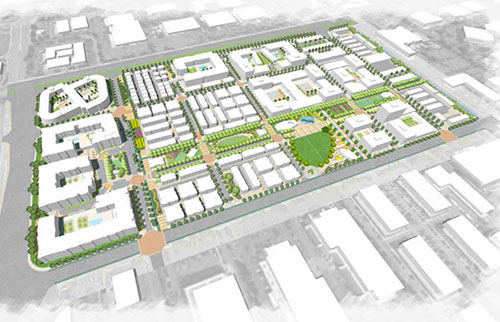
The City Council met on Nov. 29 to approve the Final Environmental Impact Report (EIR) for the Lawrence Station Area Plan (LSAP).
“Lawrence Station will become a livable urban community and a model for encouraging walking, biking and transit usage. The Lawrence Station Area will embody cultural and social diversity, mobility, and the entrepreneurial spirit that has made Silicon Valley a worldclass destination to live, work, and play,” the development’s plan says. The plan is located on the City’s website: www.santaclaraca.gov/government/departments/community-development/planning-division/specific-plans/lawrence-station.
The development will include approximately 72 acres of mixed-use development with 65 acres of developable land area, according to the development’s plan.
The development will border Sunnyvale. It’s northeast of Caltrain’s Lawrence Station with Lawrence Expressway to the west, Central Expressway to the north, Kiefer Rd. to the south, and Calabazas Creek to the east.
The plan will accommodate 3,500 residential units, roughly 100,000 square feet of retail space and 6.3 acres of public open space. Three development companies— Westlake Urban, SummerHill Housing Group and True Life Companies—submitted development plans this project.
Transportation and housing are huge themes for this development. The plan stresses that close proximity to Lawrence Station, regional transportation, and the airport paired with the higher-density residential usage will reduce reliance on cars.
What do they mean by “higher-density residential usage”? The plan says there will be townhouses, mid-rise flats, condominiums and apartments that house more people than single-family homes, which are considered low-density.
The plan asserts that the City needs more housing for the growing population coming from high-tech companies and household growth.
The project also includes a transportation demand management (TDM) plan. “The goal of a TDM plan is to decrease vehicular trips and vehicular miles. TDM measures would increase travel options, provide incentives to modify travel behavior, and reduce travel distance with efficient land-use planning,” according to the Final EIR. The development will encourage walking, bicycling and public transportation. View the Final EIR on the City’s website: www.santaclaraca.gov/Home/Components/BusinessDirectory/BusinessDirectory/87/3649
“The Plan Area will be provided with wide sidewalks, enhanced crosswalks [and] an integrated lighting and signage plan… A multi-purpose trail is proposed along the eastern edge of the Plan Area at Calabazas Creek as a future component of the circulation plan,” the plan says. Bicycle lanes and bicycle parking are also part of the plan.
Sunnyvale is also working on its own LSAP. Santa Clara worked with Sunnyvale on planning studies for the Lawrence Station Area since 2009, according to materials from a planning commission meeting on Nov. 9.
A recent concern regarding the project comes from Westlake Urban. It’s an applicant for LSAP and has a project on Ryder St.
The project’s current description includes a grade separated pedestrian crossing. Westlake Urban asserts grade separated crossings are “an extremely unattractive eyesore” and that the crossing would visually divide Westlake Urban’s existing site and the LSAP.
The Bay Area Air Quality Management District raised concerns that LSAP would be inconsistent with the 2013 City of Santa Clara Climate Action Plan (CAP). CAP is a goal to reduce emissions measured in 2008 by 15 percent by 2020.
The Final EIR asserts that LSAP will be consistent for longer-term emissions goals in 2030. Additionally, “as discussed in the draft City of Santa Clara Climate Action Plan 2016 Annual Report, Santa Clara’s 2015 GHG [green house gas] emissions were 21 percent below baseline 2008 conditions, exceeding the City’s adopted target by 6 percent. Therefore, the CAP is currently undergoing full implementation and is on track to meet its target.”
Concerns also swell around Santa Clara Unified School District (SCUSD). The Final EIR states that the project will add over 2,000 students from 12,500 new households within SCUSD’s service area by 2024.
SCUSD believes that they will need more monetary compensation from SummerHill, an LSAP developer, to accommodate these students. Read about it here: www.santaclaraweekly.com/2016/Issue-50/council-sees-pushback-on-agrihood-lawrence-station-projects.html
The school system isn’t the only one asking for money because of the project. Caltrains and VTA sent comments on the draft EIR asking for fair share contributions to offset the burden the project will put on them.
Santa Clara is making strides to urbanize the City. Maybe this development will provide a solution to the housing/job imbalance that plagues the City?





